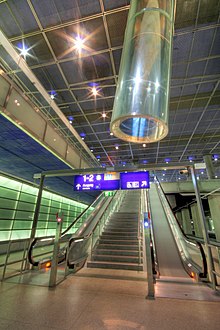Exposure (architecture)
In architecture , exposure means the illumination of a room with daylight .
Illumination with artificial light, on the other hand, is called lighting .
Basics
Buildings are illuminated through windows that are arranged in the outer walls or in the roof ( skylights , skylights ), through glass walls , facades and roofs , as well as by directing light in the interior by means of suitable room design with openings and views through to windows. In large building complexes, light wells or atriums are added to ensure sufficient lighting in all areas of the building.
When planning buildings, an adequate supply of daylight is an important aspect. Many parameters have to be taken into account, the location of the building plot, the orientation of the structure, the size and arrangement of the window openings, the depth of the rooms, the type of glazing and sun protection .
The lighting of buildings is also becoming increasingly important with regard to energy-optimized construction. Daylight systems and daylight planning are suitable for saving large amounts of energy.
Lighting as a room design innovation of the Gothic
Saint-Maurice , Vienne , 1030–1070Shed roof-like dome construction
Museu de la Ciència i de la Tècnica de Catalunya ( mNACTEC ), Terrassa , Catalonia, Lluís Muncunill , 1907/8Exposure by directing light in the interior.
Mairie Boulogne-Billancourt , Tony Garnier , 1934
Light control systems

- Main article: Daylight systems
Sometimes special light control systems are used. You can direct or filter daylight deeper into a building. Some examples:
- There are louvre systems that are installed in the room or between the two panes of double glazing and reflect the daylight onto the ceiling of the room behind. In this way, uniform illumination is achieved and greater room depth is possible. These systems are mainly used in office buildings.
- So-called "daylight tubes" are becoming increasingly popular in private residential construction . There are various names of the companies for these products. They are called, for example, daylight spot , solar spot or solatube . These are tubes with a reflective coating on the inside . They are mounted between the roof and the ceiling of the room and bring daylight (not just direct sunlight) into the house without the need for a window.
- Another system with rotary heliostats and a light guide tube was used at Potsdamer Platz station in Berlin . However, heliostats only work in direct sunlight. They cannot catch diffuse daylight.
- At the headquarters of the Hongkong and Shanghai Banking Corporation in Hong Kong by Norman Foster and a large mirror directs sunlight deep into the central atrium of the building.
- At the Kimbell Art Museum in Forth Worth , Texas by Louis Kahn, special elements filter the light and distribute it on a barrel vault to achieve even illumination of the art museum.
Norms and standards
- DIN 5034 daylight indoors
In Germany, the requirements with regard to the lighting of rooms are also specified in the workplace guidelines and in the state building codes.





